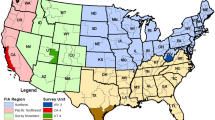Abstract
Forestry researchers frequently conduct surveys to assess woodland owner attitudes, behavior, behavioral intentions, and program adoption. However, the ability to utilize survey results in applied research is dependent upon how accurately the sample respondents reflect the reference population. One major issue in survey research is nonresponse bias. Nonresponse bias occurs when individuals do not respond to a questionnaire and is a concern because of the potential inability to make accurate inferences to a population based on responses. Researchers in this study compare two methods of questionnaire distribution (Drop-off/Pick-up and the Tailored Design Method) in terms of cost effectiveness and response rate. When compared to the Tailored Design Method (TDM), use of the Drop-off/Pick-Up (DOPU) method resulted in significantly higher response rates, provided an alternative method by which to determine survey eligibility, and had significantly higher survey implementation costs. The DOPU technique is an effective means to reduce potential nonresponse bias through increased response rate. When implementing the DOPU method, face-to-face contact and verbal communication with respondents permitted researchers to better determine eligibility than did leaving the questionnaire on the doorknob. Relying solely on respondents to indicate ineligibility on the survey instrument was not as effective as verbal confirmation of eligibility in the DOPU.

Similar content being viewed by others
Notes
The response rate was calculated by researchers using the following formula: RR6 = (I + P)/(I + P) + (R + NC + O), where I = Complete response, P = Partial response, R = Refusal, NC = Non-contact, O = Other non-contact.
Although property tax records and aerial photographs were used to identify all woodland owners in the study sites, some individuals indicated they no longer owned woodland and thus were deemed ineligible.
References
Bourke L (1994) Economic attitudes and responses to citing hazardous waste facilities in rural Utah. Rural Sociol 59:485–496
Butler BJ, Leatherberry EC (2004) America’s family forest owners. J For 102(7):4–9
Childers TL, Skinner SJ (1996) Towards a conceptualization of mail survey response behavior. Psychol Market 13(2):185–209
Clark WA, Finley JC (2007) Contracting meter readers in a drop-off/pick-up survey in Blagoevgrad, Bulgaria. Soc Nat Resour 20(7):669–673
Connelly N, Brown TL, Decker DJ (2003) Factors affecting response rates to natural resource-focused mail surveys: empirical evidence of declining rates over time. Soc Nat Res 16(3):541–549
Dillman DA, Smyth JD, Christian LM (2009) Internet, mail, and mixed-mode surveys: the tailored design method. Wiley, Hoboken 499 pp
Douglas S, Westley BH, Chaffee S (1970) An information campaign that changed community attitudes. Journal Q 47:479–497
Finley AO, Kittredge DB Jr, Stevens TH, Schweik CM, Dennis DC (2006) Interests in cross-boundary cooperation: identification of distinct types of private forest owners. Forest Sci 52(1):10–22
Janota JJ, Broussard SR (2008) Examining private forest policy preferences. For Policy Econ 10(3):89–97
Jennings SM, van Putten IE (2006) Typology of non-industrial private forest owners in Tasmania. Small Scale For Econ Manag Policy 5(1):37–56
Krannich RS, Albrecht SL (1995) Opportunity/threat responses to nuclear waste disposal facilities. Rural Sociol 60(3):435–453
Krannich RS, Greider T, Little RL (1985) Rapid growth and fear of crime: a four-community comparison. Rural Sociol 60:435–453
Lindner JR, Wingenbach GJ (2002) Communicating the handling of nonresponse error in Journal of Extension Research in Brief articles. J Exten 40(6):6RIB1 [on-line]
Lovelock CH, Stiff R, Cullwick D, Kaufman IM (1976) An evaluation of the effectiveness of drop-off questionnaire delivery. J Market Res 13:358–364
Mangione TW, Hingson R, Barrett J (1982) Collecting sensitive data: a comparison of three survey strategies. Sociol Methods Res 10(3):337–346
Melevin PT, Dillman DA, Baxter R, Lamiman CE (1999) Personal delivery of mail questionnaires for household surveys: a test of four retrieval methods. J Appl Sociol 16:69–88
Miller LE, Smith KL (1983) Handling nonresponse issues. J Exten 21(5). Available at: http://www.joe.org/joe/1983september/83-5-a7.pdf [On-line]
Olsen S, Amundsen DA, Anderson D, Guy S (1998) Community interest survey to plan a botanical center. J Exten 36(6). Available at http://www.joe.org/joe/1998december/tt2.html
Riley PJ, Kiger G (2002) Increasing survey response: the drop-off/pick-up technique. Rural Sociol 22:6–10
Ross-Davis A, Broussard SR (2007) A typology of family forest owners in North-Central Indiana. North J Appl For 24(4):282–289
Skelton P, Josiah SJ, King JW, Brandle JR, Helmers GA, Francis CA (2005) Adoption of riparian forest buffers on private lands in Nebraska, USA. Small Scale For 4(2):185–203
Steele J, Bourke L, Luloff AE, Liao P-S, Theodori GL, Krannich RS (2001) The drop-off/Pick-up method for household survey research. J Commun Develop Sociol 32(2):238–250
Stover RV, Stone WJ (1974) Hand delivery of self-administered questionnaires. Public Opin Q 37:284–287
The American Association for Public Opinion Research (2008) Standard definitions: final dispositions of case codes and outcome rates for surveys, 5th edn. AAPOR, Lenexa
Theodori GL, Luloff AE (2000) Urbanization and community attachment in rural areas. Soc Nat Resour 13(5):399–420
Vaske JJ, Gliner JA, Morgan GA (2002) Communicating judgements about practical significance: effect size, confidence intervals and odds ratios. Hum Dimens Wildl 7(4):287–300
Wiseman F (2003) On the reporting of response rates in Extension research. J Exten 41(3). Available at: http://www.joe.org/joe/2003june/comm1.php [on-line]
Acknowledgments
The authors wish to thank Professor Don Dillman for his insightful review of this manuscript and former Purdue University Undergraduate Research Assistants Jaclyn McClead, Melissa Sharkis, and Bianca Whitaker for their assistance in delivering and collecting surveys.
Author information
Authors and Affiliations
Corresponding author
Rights and permissions
About this article
Cite this article
Allred, S.B., Ross-Davis, A. The Drop-off and Pick-up Method: An Approach to Reduce Nonresponse Bias in Natural Resource Surveys. Small-scale Forestry 10, 305–318 (2011). https://doi.org/10.1007/s11842-010-9150-y
Accepted:
Published:
Issue Date:
DOI: https://doi.org/10.1007/s11842-010-9150-y




